Currency holds a significant role in the global economy, representing a nation’s economic stability and growth. Japan, renowned for its rich cultural heritage and technological advancements, boasts a currency with a history dating back centuries. However, as with any currency, the Japanese yen undergoes periodic updates and changes to ensure its security and efficiency. This article explores the question: Can I still use old Japanese yen? By delving into the evolution of the yen, the impact of currency changes on consumers and businesses, and practical considerations for handling old yen, readers will gain a comprehensive understanding of this pertinent issue.
Understanding the Evolution of the Japanese Yen:
The Japanese yen, abbreviated as JPY and symbolized by ¥, has evolved significantly over time, reflecting Japan’s economic and political transformations. Its origins can be traced back to the early 17th century, during the Edo period, when Japan transitioned from a feudal society to a centralized state under the Tokugawa shogunate. During this time, various forms of currency circulated, including gold, silver, and copper coins, issued by feudal lords and local authorities.
The modern era of the Japanese yen began in the late 19th century with the Meiji Restoration, a period of rapid industrialization and modernization. In 1871, the Meiji government introduced the yen as the official currency, adopting a decimal system based on the yen, sen, and rin. The new currency aimed to streamline trade and finance, facilitating Japan’s integration into the global economy.
Since its inception, the yen has undergone several significant transformations, including monetary reforms, devaluations, and the shift from commodity money to fiat currency. One notable event was the introduction of the yen’s current form in 1953, following the post-World War II economic reconstruction led by the Allied occupation forces. The new yen, pegged to the United States dollar under the Bretton Woods system, played a crucial role in Japan’s economic miracle of the 20th century, fueling export-led growth and industrial expansion.
Impact of Currency Changes on Consumers and Businesses:
Currency changes, whether in the form of redesigns, demonetization, or monetary policy adjustments, can have profound implications for consumers and businesses alike. In the case of the Japanese yen, updates to currency design and security features aim to combat counterfeiting and maintain public trust in the monetary system. However, these changes may also present challenges and inconveniences for those accustomed to using older denominations.
For consumers, the transition to new currency designs may require adjustments in payment habits and familiarity with updated security features. While most modern banknotes incorporate advanced anti-counterfeiting measures, such as holograms, color-shifting inks, and intricate patterns, older notes may lack these features, raising concerns about their authenticity.
Moreover, businesses must adapt to currency changes to ensure smooth transactions and compliance with legal tender laws. In cases where older denominations are phased out or replaced, businesses may face logistical challenges in accepting and processing payments, particularly if customers attempt to use outdated currency.
Practical Considerations for Handling Old Japanese Yen:
Given the ongoing evolution of the Japanese yen, individuals and businesses may encounter old currency notes in circulation. While most Japanese banknotes remain legal tender even after new designs are introduced, there are practical considerations to keep in mind when dealing with older denominations.
Firstly, it is essential to verify the authenticity of older yen notes to prevent counterfeit transactions. Familiarizing oneself with the security features of modern banknotes, such as watermarking, microprinting, and raised printing, can help distinguish genuine currency from counterfeit copies.
Secondly, individuals and businesses should be aware of any official announcements or deadlines regarding the withdrawal or demonetization of older yen notes. In some cases, central banks may establish exchange programs or grace periods during which old notes can be exchanged for new ones or deposited into bank accounts.
Furthermore, collectors and enthusiasts may find value in preserving old Japanese yen as historical artifacts or numismatic specimens. Collectible banknotes, especially those featuring rare designs or historical significance, can command premium prices in the numismatic market.
See Also: 8 Reasons Why The Yen Is Falling Against The Dollar
Conclusion:
In conclusion, the question “Can I still use old Japanese yen?” underscores the dynamic nature of currency and its implications for individuals and businesses. The evolution of the Japanese yen reflects Japan’s economic journey and commitment to maintaining a stable and resilient monetary system.
While older yen notes may still be accepted as legal tender in many cases, it is essential to stay informed about currency changes and take practical steps to ensure the authenticity and usability of banknotes. By understanding the history, impact, and practical considerations surrounding the Japanese yen, individuals and businesses can navigate the currency landscape with confidence and efficiency.


